A Comparative Study of Friction and Wear Processes of Model Metallic Biomaterials Including Registration of Friction-Induced Temperature Response of a Tribological Pair
Abstract
1. Introduction
2. Materials and Methods
2.1. Materials
2.2. Methods
3. Results and Discussion
4. Conclusions
- When sliding in the environment of a saline solution, the tested materials significantly differ in terms of the observed wear modes and the intensity of the wear phenomena. The greatest wear was observed for the tribological pair Ti gr. 2 vs. 316L stainless steel, where the predominant wear mode was the adhesive wear and scuffing-like behavior. The oscillations of the friction force registered during the sliding test might be caused by the slip-stick behavior of the both materials: micro welding on the surface asperities and the subsequent tearing off the material particles.
- As presented in the study, the temperature behavior of biomedical alloys is dependent on the tribological pair. During the sliding test, in the self-mated 316L steel, only 5 min of friction were enough to cause the temperature to rise inside the pin 5.7 °C from the baseline. Therefore, it can be suspected that sliding of the mating parts of an endoprosthesis, e.g., during a vigorous walk, can cause the temperature to locally rise, especially in the bearing surfaces. Taking into account the critical temperature for tissues and physiological fluids which equals 42 °C, the temperature changes can cause irreversible changes in the lubricating fluids of an artificial joint.
Author Contributions
Funding
Acknowledgments
Conflicts of Interest
References
- Ingham, E.; Fischer, J. Biological reactions to wear debris in total joint replacement. Proc. Inst. Mech. Eng. 2000, 214, 21–34. [Google Scholar] [CrossRef] [PubMed]
- Chen, Q.; Thouas, G.A. Metallic implant biomaterials. Mat. Sci. Eng. R. 2015, 87, 1–57. [Google Scholar] [CrossRef]
- Vezzoni, A.; Peck, J.N. Surgical Management of Hip Dysplasia. In Veterinary Surgery: Small Animal, 2nd ed.; Johnston, S.A., Tobias, K.M., Eds.; Elsevier Inc.: Missouri, MO, USA, 2012; ISBN 978-1-4377-0746-5. [Google Scholar]
- Anissian, L.H.; Stark, A.; Gustafson, A.; Good, V.; Clarke, I.C. Metal-on-metal bearing in hip prosthesis generates 100-fold less wear debris than metal-on-polyethylene. Acta Orthopeaedica Scand. 1999, 70, 578–582. [Google Scholar] [CrossRef] [PubMed]
- U.S. Food and Drugs Administation. Available online: https: //www.fda.gov/medical-devices/metal-metal-hip-implants/concerns-about-metal-metal-hip-implants (accessed on 23 October 2019).
- Yah, C.S.; Iyuke, S.E.; Simate, G.S. A Review of Nanoparticles Toxicity and Their Routes of Exposures. Iran. J. Pharm. Sci. 2012, 8, 299–314. [Google Scholar]
- Madl, A.K.; Liong, M.; Kovochich, M.; Finley, B.L.; Paustenbach, D.J.; Oberdörster, G. Toxicology of wear particles of cobalt-chromium alloy metal-on-metal hip implants Part I: Physicochemical properties in patient and simulator studies. Nanomed. NBM 2015, 11, 1201–1215. [Google Scholar] [CrossRef] [PubMed]
- Merola, M.; Affatato, S. Material for Hip Prostheses: A review of wear and loading considerations. Materials 2019, 12, 495. [Google Scholar] [CrossRef]
- Matusiewicz, H. Potential release of in vivo trace metals from metallic medical implants in the human body: From ions to nanoparticles–A systematic analytical review. Acta Biomater. 2014, 10, 2379–2403. [Google Scholar] [CrossRef]
- Łępicka, M.; Grądzka-Dahlke, M.; Pieniak, D.; Pasierbiewicz, K.; Niewczas, A. Effect of mechanical properties of substrate and coating on wear performance of TiN- or DLC-coated 316LVM stainless steel. Wear 2017, 382, 62–70. [Google Scholar] [CrossRef]
- Łępicka, M.; Grądzka-Dahlke, M. Direct Current and Pulsed Direct Current Plasma Nitriding of Ferrous Materials—A Critical Review. Acta Mech. Autom. 2016, 10, 150–158. [Google Scholar] [CrossRef]
- Łapaj, Ł.; Wendland, J.; Markuszewski, J.; Mróz, A.; Wiśniewski, T. Retrieval analysis of titanium nitride (TiN) coated prosthetic femoral heads articulating with polyethylene. J. Mech. Behav. Biomed. Mater. 2016, 55, 27–139. [Google Scholar] [CrossRef]
- Fellah, M.; Labaïz, M.; Assala, O.; Dekhil, L.; Zerniz, N.; Iost, A. Tribological behavior of biomaterial for total hip prosthesis. Matériaux Tech. 2014, 102, 601. [Google Scholar] [CrossRef][Green Version]
- Zhao, G.H.; Aune, R.E.; Espallargas, N. Tribocorrosion studies of metallic biomaterials: The effect of plasma nitriding and DLC surface modifications. J. Mech. Behav. Biomed. Mater. 2016, 63, 100–114. [Google Scholar] [CrossRef] [PubMed]
- Shen, G.; Zhang, J.F.; Fang, F.Z. In vitro evaluation of artificial joints: A comprehensive review. Adv. Manuf. 2019, 7, 1–14. [Google Scholar] [CrossRef]
- Cvijović-Alagić, I.; Cvijović, Z.; Mitrović, S.; Rakin, M.; Veljović, Đ.; Babić, M. Tribological behaviour of orthopaedic Ti-13Nb-13Zr and Ti-6Al-4V alloys. Tribol. Lett. 2010, 40, 59–70. [Google Scholar] [CrossRef]
- Li, G.; Peng, Q.; Wang, Y.; Gao, J.; Chen, S.; Wang, J.; Shen, B. Effect of DC plasma nitriding temperature on microstructure and dry-sliding wear properties of 316L stainless steel. Surf. Coat. Technol. 2008, 202, 2749–2754. [Google Scholar] [CrossRef]
- Okazaki, Y.; Gotoh, E. Comparison of metal release from various metallic biomaterials in vitro. Biomaterials 2005, 26, 11–21. [Google Scholar] [CrossRef]
- Suresh, K.S.; Geetha, M.; Richard, C.; Landoulsi, J.; Ramasawmy, H.; Suwas, S.; Asokamani, R. Effect of equal channel angular extrusion on wear and corrosion behavior of the orthopedic Ti-13Nb-13Zr alloy in simulated body fluid. Mater. Sci. Eng. C 2012, 32, 763–771. [Google Scholar] [CrossRef]
- Vilhena, L.; Oppong, G.; Ramalho, A. Tribocorrosion of different biomaterials under reciprocating sliding conditions in artificial saliva. Lubr. Sci. 2019, 31, 364–380. [Google Scholar] [CrossRef]
- Fisher, J.; Dowson, D.; Hamdzah, H.; Lee, H.L. The effect of sliding velocity on the friction and wear of UHMWPE for use in total artificial joints. Wear 1994, 195, 219–225. [Google Scholar] [CrossRef]
- Bergmann, G.; Fraichen, F.; Rohlmann, A.; Verdonschot, N.; van Lenthe, G.H. Frictional heating of total hip implants. Part 1. measurements in patients. J. Biomech. 2001, 34, 421–428. [Google Scholar] [CrossRef]
- Muthukumaran, V.; Selladurai, V.; Nandhakumar, S.; Senthilkumar, M. Experimental investigation on corrosion and hardness of ion implanted AISI 316L stainless steel. Mater. Des. 2010, 31, 2813–2817. [Google Scholar] [CrossRef]
- Çelik, A.; Bayrak, Ö.; Alsaran, A.; Kaymaz, İ.; Yetim, A.F. Effects of plasma nitriding on mechanical and tribological properties of CoCrMo alloy. Surf. Coat. Technol. 2008, 11, 2433–2438. [Google Scholar] [CrossRef]
- Bauer, J.; Cella, S.; Pinto, M.M.; Rodrigues Filho, L.E.; Reis, A.; Loguercio, A.D. Effect of argon purity on mechanical properties, microstructure and fracture mode of commercially pure (cp) Ti and Ti-6Al-4V alloys for ceramometal dental prostheses. Biomed. Mater. 2009, 4, 065002. [Google Scholar] [CrossRef] [PubMed]
- Damm, P.; Dymke, J.; Ackermann, R.; Bender, A.; Graichen, F.; Halder, A.; Beier, A.; Bergmann, G. Friction in Total Hip Joint Prosthesis Measured In Vivo during Walking. PLoS ONE 2013, 8, e78373. [Google Scholar] [CrossRef] [PubMed]
- Barril, S.; Mischler, S.; Landold, D. Influence of fretting regimes on the tribocorrosion behaviour of Ti6Al4V in 0.9 wt.% sodium chloride solution. Wear 2004, 256, 963–972. [Google Scholar] [CrossRef]
- Garbacz, H.; Grądzka-Dahlke, M.; Kurzydłowski, K. The tribological properties of nano-titanium obtained by hydrostatic extrusion. Wear 2007, 263, 572–578. [Google Scholar] [CrossRef]
- O’Donnell, L.J.; Michal, G.M.; Ernst, F.; Kahn, H.; Heuer, A.H. Wear maps for low temperature carburised 316L austenitic stainless steel sliding against alumina. Surf. Eng. 2010, 26, 284–292. [Google Scholar] [CrossRef]
- Bergmann, G.; Graichen, F.; Rohlmann, A.; Verdonschot, N.; van Lenthe, G.H. Frictional heating of total hip implants. Part 2: Finite element study. J. Biomech. 2001, 34, 429–435. [Google Scholar] [CrossRef]
- Giering, K.; Lamprecht, I.; Minet, O. Specific heat capacities of human and animal tissues. Proc. SPIE 1996, 2624, 188–197. [Google Scholar] [CrossRef]
- Outeiro, J.C.; Umbrello, D.; M’Saoubi, R. Experimental and numerical modelling of the residual stresses induced in orthogonal cutting of AISI 316L steel. Int. J. Mach. Tool Manuf. 2006, 46, 1786–1794. [Google Scholar] [CrossRef]
- González-Alonso, J.; Quistorff, B.; Krustrup, P.; Bangsbo, J.; Saltin, B. Heat production in human skeletal muscle at the onset of intense dynamic exercise. J. Phys. 2004, 524, 603–615. [Google Scholar] [CrossRef] [PubMed]
- Ruggiero, A.; D’Amato, R.; Gómez, E.; Merola, M. Experimental comparison on tribological pairs UHMWPE/TIAL6V4 alloy, UHMWPE/AISI316L austenitic stainless and UHMWPE/AL2O3 ceramic, under dry and lubricated conditions. Tribol. Int. 2016, 96, 349–360. [Google Scholar] [CrossRef]
- Volstad, N.J.; Schaefer, S.L.; Snyder, L.A.; Meinen, J.B.; Sample, S.J. Metallosis with pseudotumour formation: Long-term complication following cementless total hip replacement in a dog. Vet. Comp. Orthop. Traumatol. 2016, 29, 283–289. [Google Scholar] [CrossRef] [PubMed][Green Version]
- Kurtz, S.M.; Hozack, W.; Marcolongo, M.; Turner, J.; Rimnac, C.; Edidin, A. Degradation of Mechanical Properties of UHMWPE Acetabular Liners Following Long-Term Implantation. J. Arthroplast. 2003, 18, 68–78. [Google Scholar] [CrossRef]
- Hashemi, B.; Rezaee Yazdi, M.; Azar, V. The wear and corrosion resistance of shot peened–nitrided 316L austenitic stainless steel. Mater. Des. 2011, 32, 3287–3292. [Google Scholar] [CrossRef]
- Łępicka, M.; Grądzka-Dahlke, M.; Pieniak, D.; Pasierbiewicz, K.; Kryńska, K.; Niewczas, A. Tribological performance of titanium nitride coatings: A comparative study on TiN-coated stainless steel and titanium alloy. Wear 2019, 422, 68–80. [Google Scholar] [CrossRef]
- Czichos, H. Introduction to friction and wear. In Friction and Wear of Polymer Composites; Friedrich, K., Ed.; Elsevier Science: Amsterdam, The Netherlands, 1996. [Google Scholar]
- Jenko, M.; Gorenšek, M.; Godec, M.; Hodnik, M.; Batič, B.Š.; Donik, Č.; Grant, J.T.; Dolinar, D. Surface chemistry and microstructure of metallic biomaterials for hip and knee endoprostheses. Appl. Surf. Sci. 2018, 427, 584–593. [Google Scholar] [CrossRef]
- Pourzal, R.; Catelas, I.; Theissmann, R.; Kaddick, C.; Fischer, A. Characterization of wear particles generated from CoCrMo alloy under sliding wear conditions. Wear 2011, 271, 1658–1666. [Google Scholar] [CrossRef]
- Chiba, A.; Kumagai, K.; Nomura, N.; Miyakawa, S. Pin-on-disk wear behavior in a like-on-like configuration in a biological environment of high carbon cast and low carbon forged Co–29Cr–6Mo alloys. Acta Mater. 2007, 55, 1309–1318. [Google Scholar] [CrossRef]
- Jiménez, A.E.; Bermúdez, M.D. Friction and wear. In Tribology for Engineers: A Practical Guide; Davim, J.P., Ed.; Woodhead Publishing: Cambridge, UK, 2011; ISBN 978-0857091147. [Google Scholar]
- Wang, Z.; Xiao, Z.; Huang, C.; Wen, L.; Zhang, W. Influence of Ultrasonic Surface Rolling on Microstructure and Wear Behavior of Selective Laser Melted Ti-6Al-4V Alloy. Materials 2017, 10, 1203. [Google Scholar] [CrossRef]

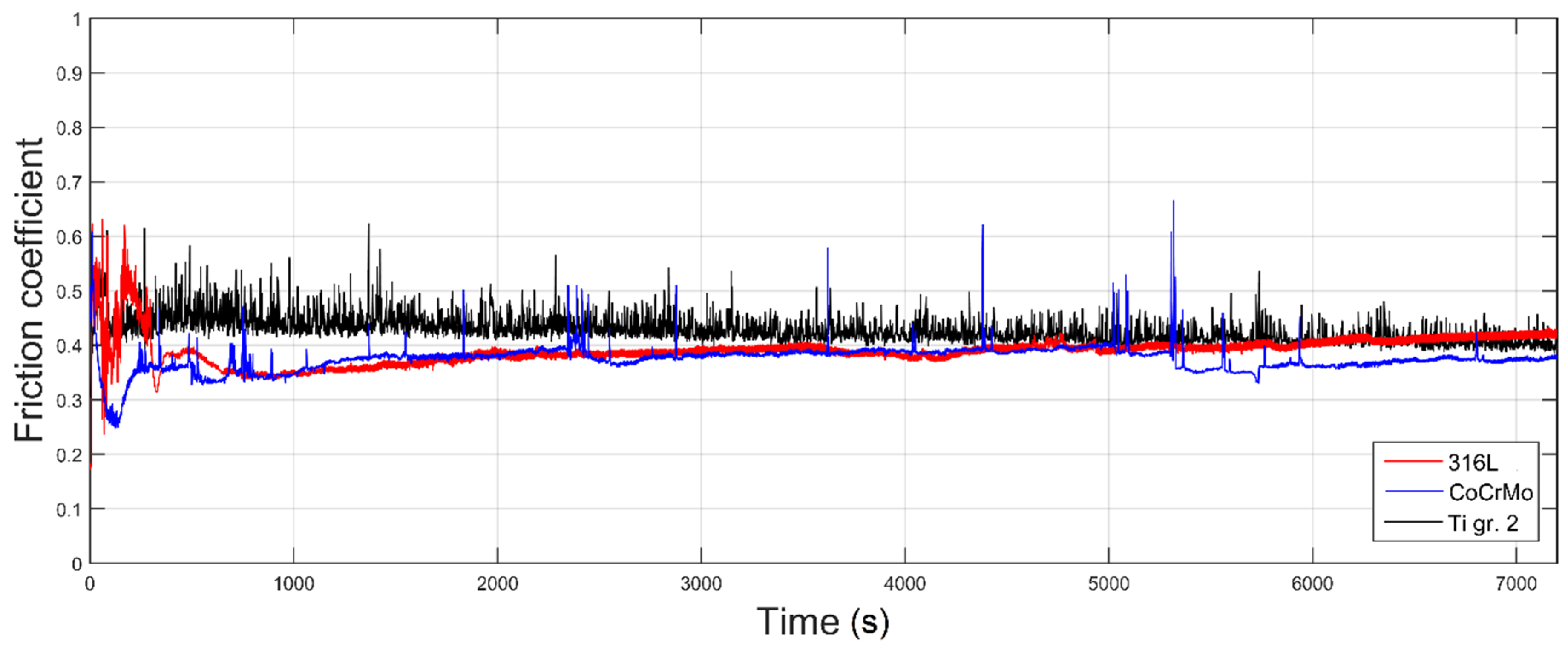
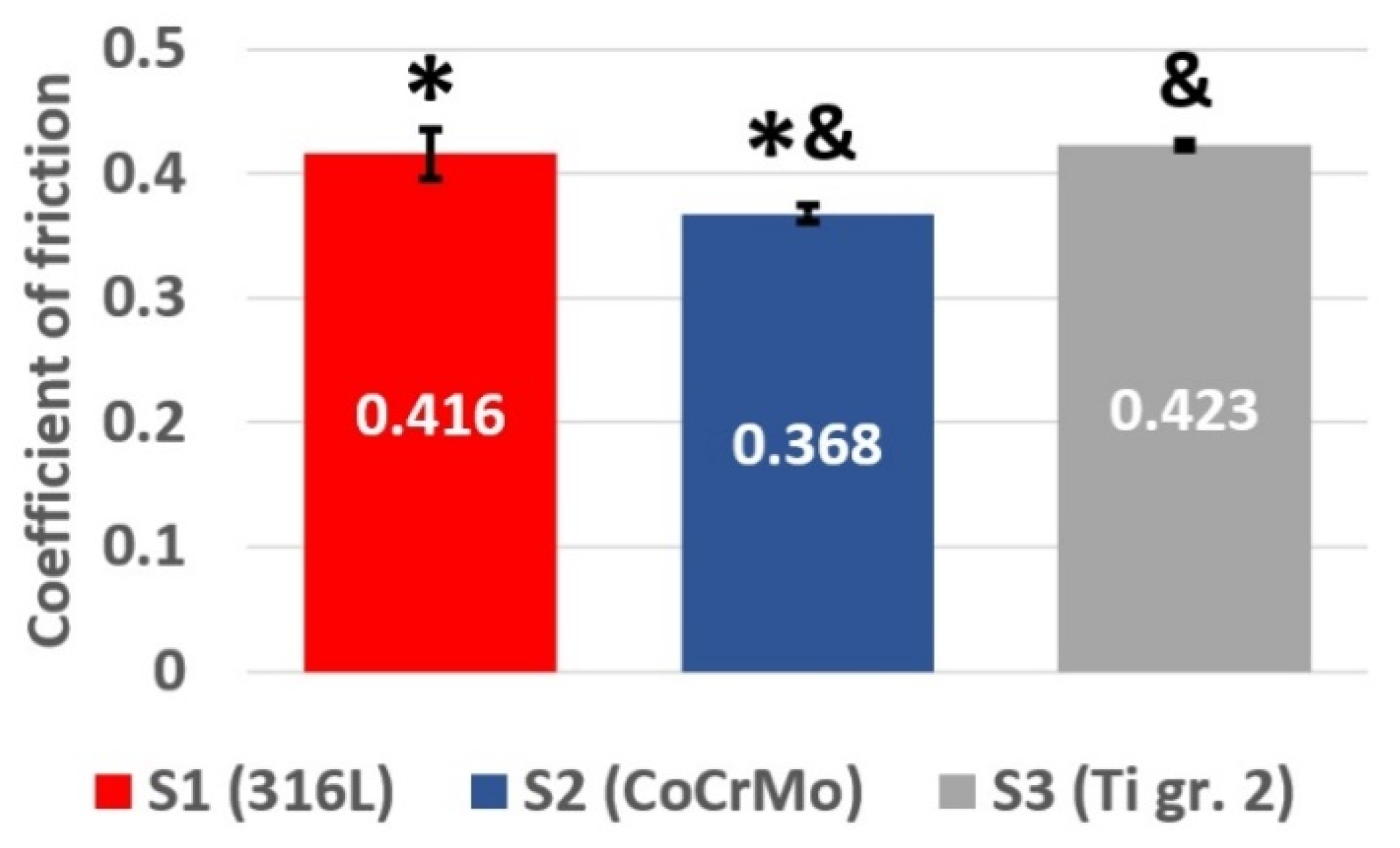
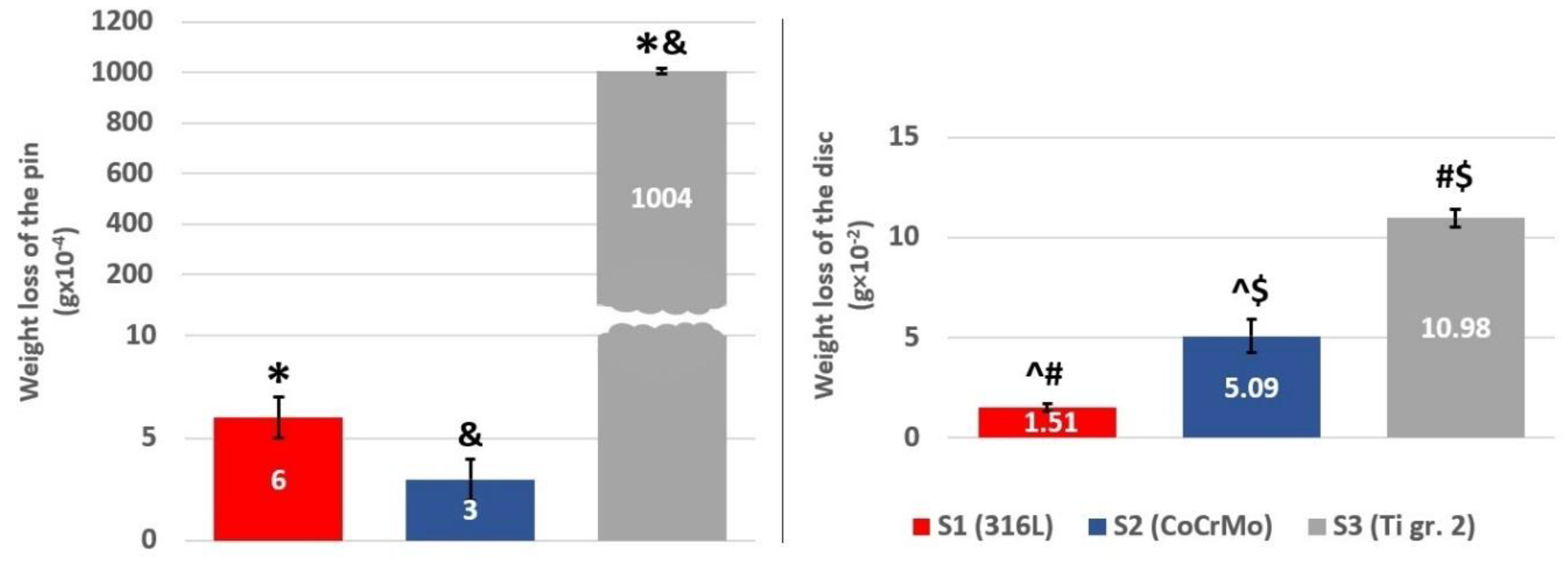

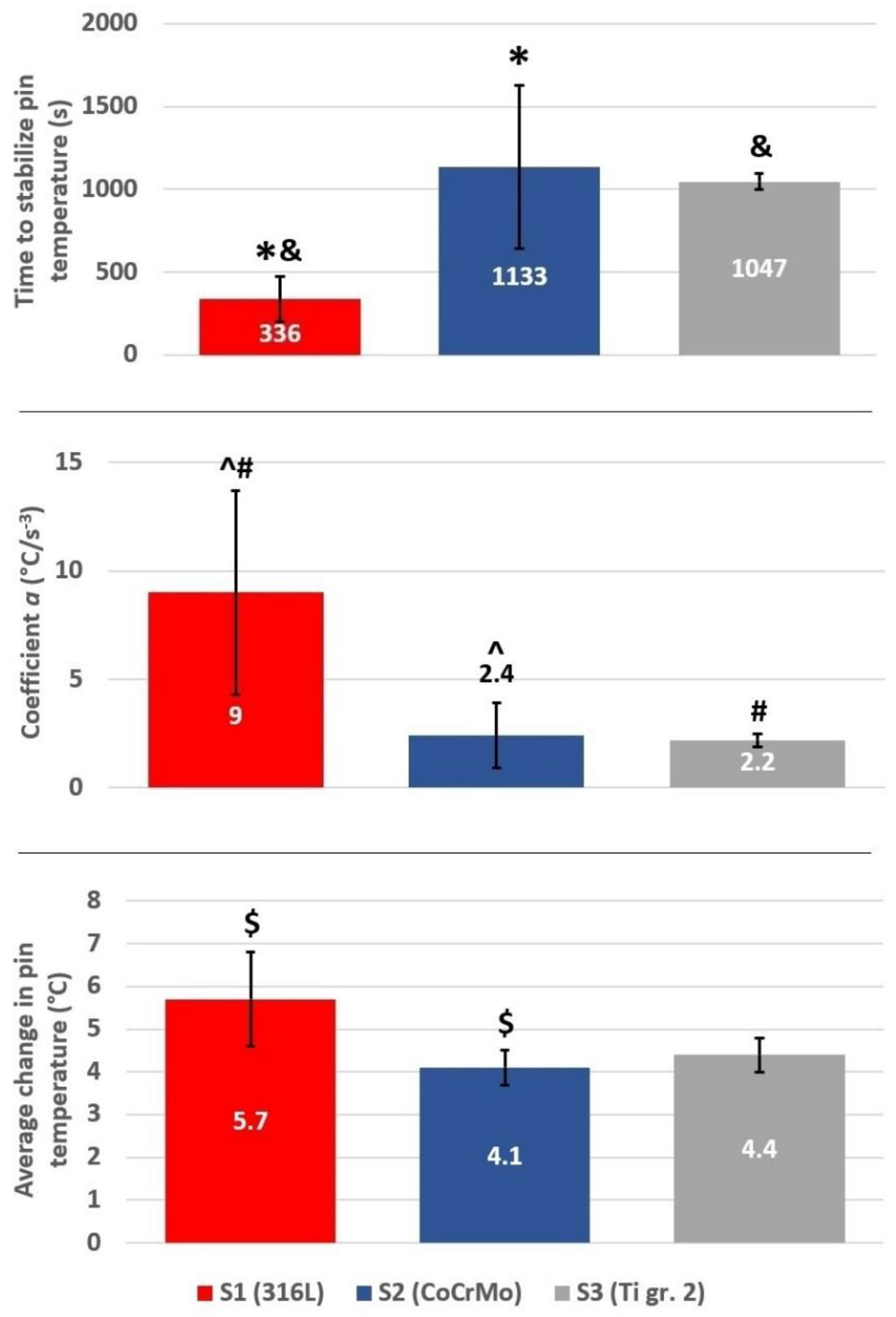
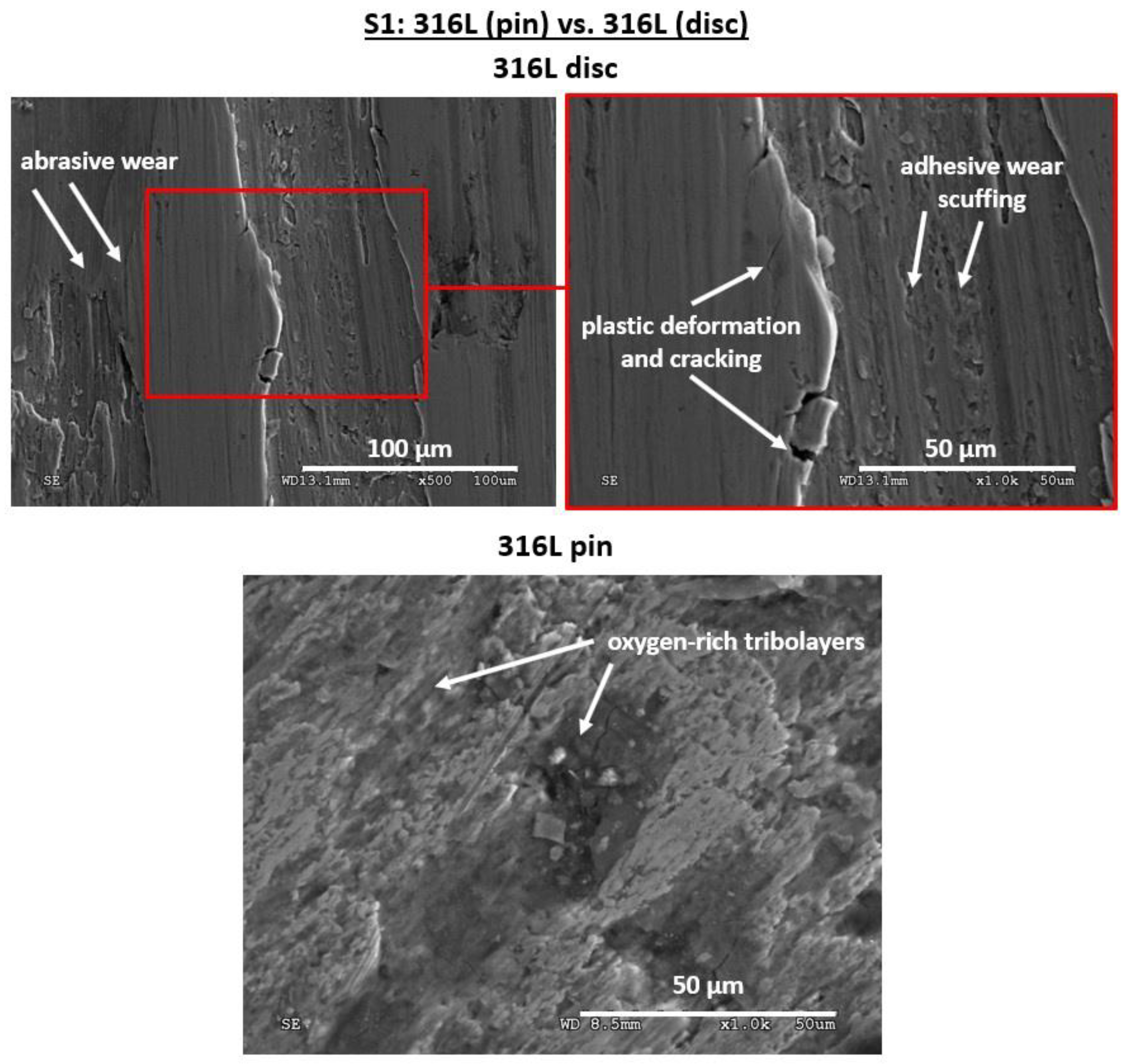
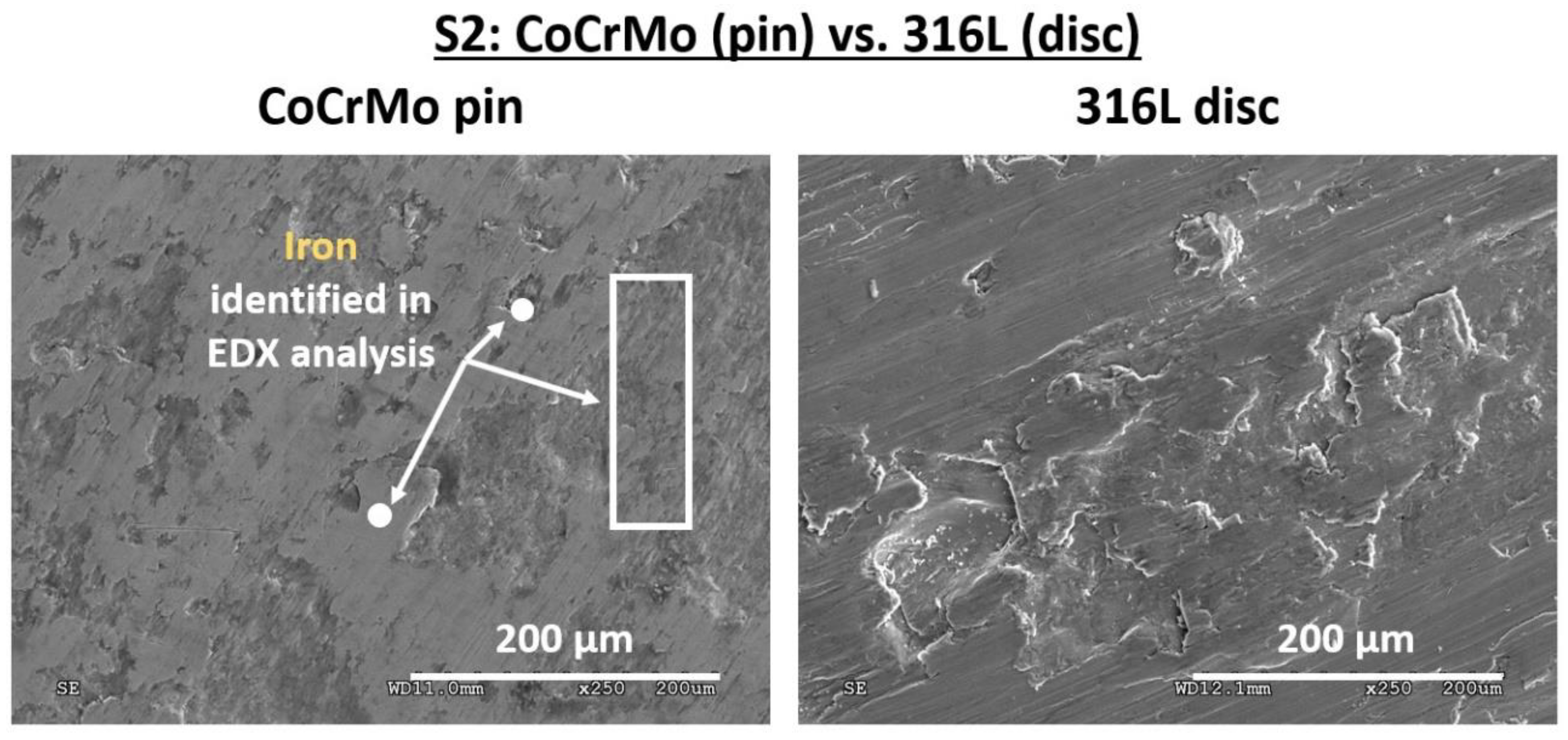
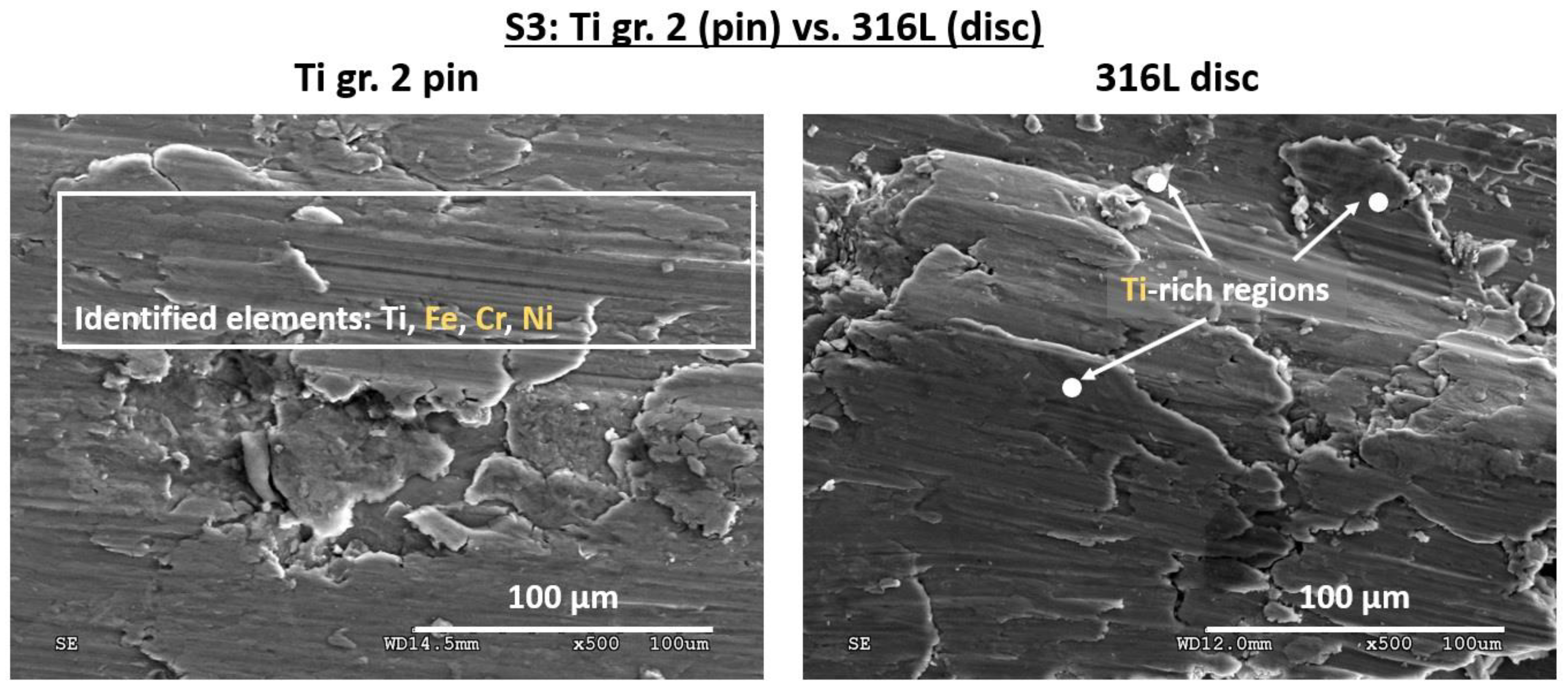
| Frictional Pair No. | Pin Material | Disc Material | Pin Ra (µm) | Vickers Microhardness of the Pin Material (HV0.1) |
|---|---|---|---|---|
| S1 | 316L | 316L | 0.015 ± 0.001 | 195 [23] |
| S2 | CoCrMo | 316L | 0.014 ± 0.001 | 440 [24] |
| S3 | Ti gr. 2 | 316L | 0.022 ± 0.002 | 190 [25] |
| Age (Years) | Gender | Mean Sliding Speed (m/s) | |
|---|---|---|---|
| Extension | Flexion | ||
| 56 | m | 0.02 | 0.04 |
| 62 | m | 0.03 | 0.05 |
| 60 | m | 0.02 | 0.06 |
| 50 | m | 0.03 | 0.06 |
| 62 | f | 0.02 | 0.08 |
| 69 | m | 0.03 | 0.05 |
| 53 | m | 0.03 | 0.06 |
| 56 | m | 0.03 | 0.06 |
© 2019 by the authors. Licensee MDPI, Basel, Switzerland. This article is an open access article distributed under the terms and conditions of the Creative Commons Attribution (CC BY) license (http://creativecommons.org/licenses/by/4.0/).
Share and Cite
Łępicka, M.; Ciszewski, A.; Golak, K.; Grądzka-Dahlke, M. A Comparative Study of Friction and Wear Processes of Model Metallic Biomaterials Including Registration of Friction-Induced Temperature Response of a Tribological Pair. Materials 2019, 12, 4163. https://doi.org/10.3390/ma12244163
Łępicka M, Ciszewski A, Golak K, Grądzka-Dahlke M. A Comparative Study of Friction and Wear Processes of Model Metallic Biomaterials Including Registration of Friction-Induced Temperature Response of a Tribological Pair. Materials. 2019; 12(24):4163. https://doi.org/10.3390/ma12244163
Chicago/Turabian StyleŁępicka, Magdalena, Artur Ciszewski, Karol Golak, and Małgorzata Grądzka-Dahlke. 2019. "A Comparative Study of Friction and Wear Processes of Model Metallic Biomaterials Including Registration of Friction-Induced Temperature Response of a Tribological Pair" Materials 12, no. 24: 4163. https://doi.org/10.3390/ma12244163
APA StyleŁępicka, M., Ciszewski, A., Golak, K., & Grądzka-Dahlke, M. (2019). A Comparative Study of Friction and Wear Processes of Model Metallic Biomaterials Including Registration of Friction-Induced Temperature Response of a Tribological Pair. Materials, 12(24), 4163. https://doi.org/10.3390/ma12244163






